
The summer that is, or was, or may yet be
While some of the usual signals of summer have come and gone, including convocation and some playtime in the British Library, and we continue to contend with the annual snakes and ladders challenge of finding an open café or coffee shop on campus, it has otherwise been a busier than usual summer in the Deans Office. Responding to administrative turnover at the university, providing input to the Strategic Mandate Agreement, preparing for the Waterloo Budget Model, scrambling to draft nominations for Canada 150 Chairs, adjusting to the recently announced return to corridor funding, and managing an unusual number of hirings stretching into the summer have kept us hopping.
I was however fortunate to have 10 days of archival therapy in London between the two heat waves that have battered the city. I also attended a couple of exhibitions celebrating the 40th anniversary of punk. While one can quibble over when punk began (and even where), I am fascinated by the seemingly insatiable public need to find anniversaries to celebrate. Over the past ten years, it seems that there is always some anniversary being celebrated in the UK – sometimes these overlap with ones in Canada: They had the Somme in 1916; we have Vimy in 1917. Of course, this year we have Canada 150, an anniversary that has proven to be fraught with more challenges than the celebration of the birth of punk.
As part of the Faculty of Arts’ response to Canada 150, and in part a celebration of the 60th anniversary of the University, we are partnering with the City of Waterloo and Wilfrid Laurier University to produce three panel discussions in the fall that look at the anniversary through different lenses. The first will look at Vimy, an event that was carefully and quite deliberately crafted to be part of our foundational mythology. The second will take up the report of the Truth and Reconciliation Commission and its calls to actions, many of which demand from us a determined and collaborative effort to recover and respect the silenced histories of our first peoples. I was honoured to introduce Roberta Jamieson as the University of Waterloo’s distinguished convocation speaker in June. It was without doubt one of the most moving talks I have had the pleasure of hearing, and nobody in the audience could have left without appreciating just how important those calls to action are. The last panel looks at how the dominant historical narrative woven through our celebrations has eclipsed the histories of many other groups whose past, present, and future is bound up with our country. I’m looking forward to this series, and I’m grateful to the faculty members who will participate on the panels. I hope that many in the Arts community can attend (watch for details soon).
In the meantime, and despite my own sense of summer's elusiveness, I wish you and your families a happy and safe second half of summer.
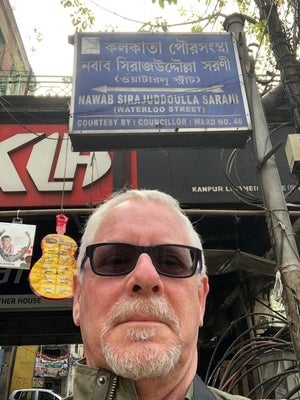
Comically speaking
» Linda Warley talks about Canadian Graphic, her co-edited book that won the Gabrielle Roy Prize (the second for a UWaterloo English prof)
Comics to graphic texts
Comics means everything from the serialized comics in newspapers to sophisticated works of art in graphic form. We tend to use the term graphic novel to encompass all forms, but in our book Canadian Graphic, the essays look very specifically at graphic books that are not novels, but are based on autobiography (writing about the self) or biography (writing about another ‘real’ person). The subtitle of our book is “Picturing life narratives.”
The genre is generally associated with Marvel superheroes; but Canadian work does not always fit with that genre – not at all! They are often anti-heroic; in fact, they are sometimes downright mundane in terms of the everyday-ness of the lives depicted.
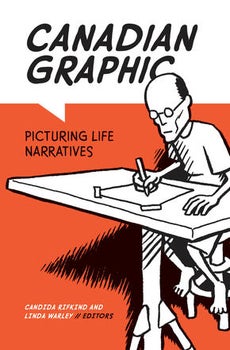
This is the first book-length publication that specifically focuses on Canadian authors, and that was the most important thing to Candida Rifkind, my co-editor, and me. While there are many well-known Canadian comics authors such as Seth and Chester Brown, they tend to be subsumed into North American lists and studies rather than being recognized specifically as Canadian authors.
When we were reading submissions for the book, we were really impressed with the kind of sophisticated analytical strategies that the authors brought to the genre – the kind of nuance they identified in the graphic texts.
Are graphic texts a good way into studying literature?
They can be! We have to develop new forms of literacy, and I think that’s fine – things change. Teaching graphic texts in undergrad courses is a wonderful opportunity to teach students about reading at a critical distance. Unlike literary texts, you’re looking at pictures and words, the frames on the page and their arrangement, the amount of white space, the colours -- all those elements.
Graphic texts (or comics) have not been particularly valued as a form of literature until quite recently. But graphic texts are definitely a dominant form now and are taught in universities and high schools; libraries including, academic libraries, have large collections; and there are plenty of publications and conferences focused on the genre.
A few favourite graphic texts
I find the memoir Tangles by Sarah Leavitt about her mother’s dementia is really moving; and Can’t We Talk About Something More Pleasant? by Roz Chas is about the author’s relationship with her aging parents – something I can really relate to. That’s what the graphic form can do: for instance, when the artist draws the narrator in a state of real anxiety or anger, it can be conveyed in a really powerful way in an image; you can look at it for a second and feel that rage or frustration.
Among Canadian graphic texts, I would say Chester Brown’s Riel is a deeply thoughtful and well historicized work about the Northwest Resistance. I’ve used it in my Métis literature class because it gives a basic background and really interesting insights into the final years of Riel’s life – and it’s a fast read. Chester Brown is very self-conscious that he is representing the story as a non- Métis, so there are footnotes and other para-textual material. And there’s no question of Seth’s influence and power: his visual style is instantly recognizable and he has an international reputation.
Who would be interested in Canadian Graphic?
Scholars of autobiography would use it, many of whom look at multi-modal texts – texts that are not traditionally just written. There is a lot of interest in Canadian courses. Last week I was in Montreal and went to the Drawn & Quarterly bookstore (Drawn & Quarterly is a leading publisher of graphic texts), and it was nice to see the book is carried there -- especially given it’s a scholarly book in a mainstream store. Words Worth Books here in town sells it, and McNally Robinson in Winnipeg held a book launch for us. So, it’s being sold to the general public.
It’s a very readable book. The writers did an excellent job making their essays accessible to a broad audience. In fact, that’s one of the reasons it won the Gabrielle Roy Prize: readability is one of the criteria.
For me, it’s a career highlight, to win that prize for a book of criticism. And, my colleague Win Siemerling won the Gabrielle Roy Prize last year; it’s remarkable that two profs in the same department at Waterloo have won the prize two years in a row. I think it really does say something about the strength of Canadian studies here.
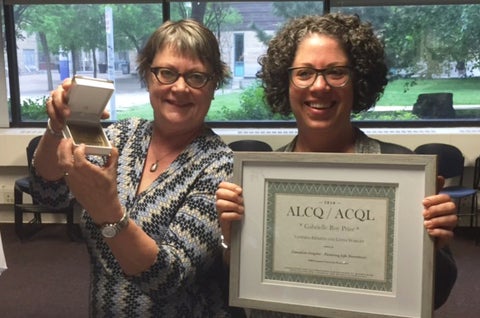
Did you know about the goldmine of books published each year by researchers in the Faculty of Arts? Check the Research>Books page to keep up.
Inside Spanish and Latin American Studies
» David Rozotto, Assistant Professor, Spanish and Latin American Studies
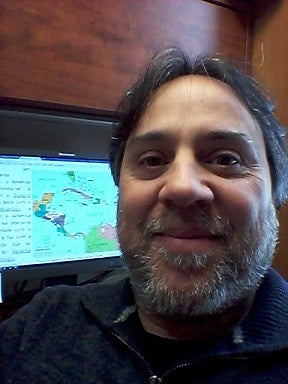
How do you describe your department to someone from away?
We are a small, yet dynamic department with a curriculum of interrelated courses, and practical programs in Spanish language, English/Spanish translation and Latin American studies. Our goal is twofold: to make our students fluent in Spanish; and to provide them with knowledge of, and appreciation for the Hispanic culture. We are committed to contribute to students’ professional careers by preparing them to understand the global cultural environment, to be better communicators, and to reach their full potential as participants of a multicultural society.
What's an especially popular course offered by Spanish and Latin American Studies, and why you think it's popular?
SPAN 150 The Hispanic World Through Literature and the Arts is one of the recently created courses that has promptly become very popular. Besides the dynamism of Prof. Mario Boido, creator and instructor of the course, SPAN 150 is appealing to students because, from a Hispanic perspective, it deals with issues that are pan-cultural (ethnicity, gender, sexuality, nationhood) with an emphasis in the visual arts so popular among the new generation of students.
Tell us about the culture within the department, or, an average day in the life of Spanish and Latin American Studies.
When we meet in the hallways to chat about current Canadian, Hispanic or World affairs, it usually starts with two of us bumping into each other and commenting on an ongoing issue. The others will join because either they are passing by, or because they hear the discussion from their offices (we usually keep open doors). Each one freely expresses their opinion. We try to arrive at a consensus, and attempt to fix the world in the process. No matter how long the discussion goes, we always walk back to our offices with a smile and ready to tackle the rest of the day.
What do you, personally, like about living and working in the Kitchener-Waterloo?
I am from what used to be a small city in Guatemala. When I came to Canada, I lived in Saskatoon before I moved to the big metropolises of Ottawa and then Toronto. I love living again in a small city. I really enjoy the sense of community, which extends to campus life, and the politeness of people. I also like the green spaces and the easy access to the countryside. If I ever feel the need for the large urban centre, TO is there, but, really, with our own symphony, great theater, excellent restaurants, fantastic farmers’ markets, outstanding breweries, I don’t need anything else. I am home!
How North America's first mathematics faculty had its beginnings in Arts
» Professor Emeritus Ken McLaughlin
This story is an excerpt of the article, Ralph Stanton and Mathematics @ UWaterloo: Surprising Beginnings, originally published in WatTimes. With thanks to Prof. McLaughlin.

Sixty years ago, Gerald Hagey, the then president of a small Lutheran college in Waterloo, and its Dean of Arts, the Reverend Lloyd Schaus, hesitatingly approached the out-of-the-way garret-like office of a young Associate Professor at the University of Toronto. They were there to see if the professor was interested in coming to Waterloo College to become Head of a newly-formed Department of Mathematics.
Ralph Stanton accepted their invitation and in 1957 left Toronto to become Head of Mathematics at an unprepossessing college in Waterloo.
“When the split with Waterloo College came [in 1959]… it was just sort of agreed as a consensus among President Hagey and the people in science and engineering that it would be a good idea if mathematics was in the Arts Faculty … simply because the Arts Faculty was almost nonexistent.” [Stanton said years later in an interview with Prof. McLaughlin and a graduate student in History.]
Stanton had previously, and with considerable controversy, insisted that the University create its own non-Lutheran Arts Faculty quite apart from the Arts programs offered at Waterloo College.
“In a sense this gave us a separate identity from Science, which is a good thing because, in most universities across Canada [at that time], Science means Physics and Chemistry...
"So I think that I preferred being in Arts because in Arts we did have a separate identity."
In fact, Stanton and his colleagues had first voted to be in Science and it was the political desire to force the creation of a new Faculty of Arts that led them to reconsider. How fortuitous this was cannot be overstated, although as we shall see, Ralph Stanton was a master politician.
Not one disposed to wait, in April, 1965 Stanton approached President Hagey with a plan for creating a Faculty of Mathematics. He conceded that he was attempting to create something without precedent. No other university in North America had a Faculty of Mathematics, nor did the University have an established protocol for considering it.
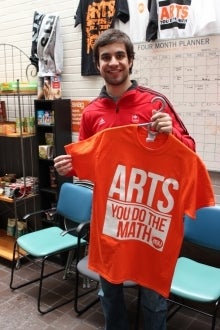
The politics are equally interesting. Members of the Arts Faculty were happy to see Mathematics move out on its own and to end Stanton’s interference in their affairs.
“I know that within the Arts Faculty, when the faculty voted their opinion as to whether it was a good thing or not, we did win the vote, but that was largely because at least 40% of the people were in the mathematics department, which at that time was the largest segment. And we did get 100% support from all of the department heads in Arts — that was because they were all good friends of mine.”
Congratulations to our good friends in the Faculty of Mathematics on celebrating their 50th anniversary this year. But, really, Math began 60 years ago, became an Arts department 57ish years ago, left Arts after five years… Okay, that doesn't quite add up. You do the math.
2017 Arts Awards for excellence in teaching, service, and research
» On April 19, 2017, nine Arts Awards were presented to faculty and staff. Here they are, along with citation excerpts. Congratulations to them all!
Excellence in Teaching
Ron Kroeker, Classical Studies: He has averaged eight to ten courses per year (including online courses), and has taught close to half the courses offered by Classical Studies. His ability to take on such a variety of courses, large and small, featuring different genres, different cultures, and different languages is phenomenal: he is by far our most versatile teacher. His popularity with the students arises not simply from his patient good nature and dry sense of humour, but also from his ability to coach, to mentor, and to facilitate student academic success.
Mariam Mufti, Political Science: In addition to outstanding course evaluations, she is an innovator in course delivery and teaching techniques, including in her explorations of blended learning, which integrate face-to face interaction with online learning: not lecture-based but, rather, a dialogic and dynamic interaction. Among other highlights, she has taken the lead in designing, implementing and delivering a new course, Political Science Beyond the Classroom, in which students learn how to leverage political science training for future careers.
Karin Schmidlin, Stratford Campus: She has exceptionally high teaching evaluations, and students make it very clear that she is a particularly invested and caring instructor. She mentors students long after the course is over. She has outstanding pedagogical approaches, which she is often asked to demonstrate as mini lectures at recruitment events, which consistently impress the prospective student and parents. Karin has led intensive design camps, alumni panels, and extra-curricular other initiatives with excellent feedback from participants.
Excellence in Research
Derek Besner, Psychology: Over his 43-year research career (since his first published paper), Besner has become an international leader in reading and cognitive science. His research has been continuously supported by NSERC since his arrival at Waterloo in 1980. He “pushes us to dig deeper, both to reject explanations that do not work and to come up with new ones. He has an uncanny knack for clever empirical studies that make other scientists say, I wish I’d thought of that.”
Alice Kuzniar, Germanic and Slavic Studies: She has built an international reputation for outstanding, pioneering work in her core research field, German literature, culture, and intellectual history. She has an impressive number of single-authored books of interest and impact for a range of audiences. Her diverse research has had broad disciplinary and interdisciplinary impact across literature, philosophy, psychoanalysis, visual arts, semiotics, and medical fields.
Excellence in Service
Jasmin Habib, Political Science: She has a strong record of service at all levels: in her home department, in the Faculty of Arts, at the university level, in the community, and professionally. Service roles include coordinator of the Department of Political Science International Trade Field Trip program, and Director of the Faculty of Arts Global Engagement Program, served on the FAUW Board of Directors. Her service excellence contributes to the stature and reputation of the Faculty of Arts on campus, in the community, and in the academy.
Ivan Jurakic, Fine Arts: He is an internationally respected art gallery administrator and curator, and a practicing artist himself. He has recognized the pedagogical potential of UWAG (University of Waterloo Art Gallery) and has made that a priority mandate in the gallery’s programming. He regularly contributes his expertise to undergrad and MFA critiques, which he does with focus and passion and a clear interest in the vitality of the community. Ivan has put UWAG on the national art scene map.
Julie Mulvey, Arts Undergraduate Office: She has provided outstanding service to our students, our Faculty, and our University for many years. Her work on systems such as course selection and scheduling has improved the experience of thousands of students across the University. Her attitude really sets her apart. Julie is always willing to help: she not only improves how things work, but she leaves the people she helped feeling more effective and positive about their work.
Andrea West, Stratford Campus: In addition to consistently carrying out her responsibilities as Academic Administrative Assistant with excellence, Andrea has initiated, developed and implemented several key improvements to advising processes and student communication. These include creating an Academic Advising Syllabus, implementing a widget for LEARN to ensure struggling students are helped, and she facilitated the implementation of a GBDA Living and Learning Community for Fall 2017.
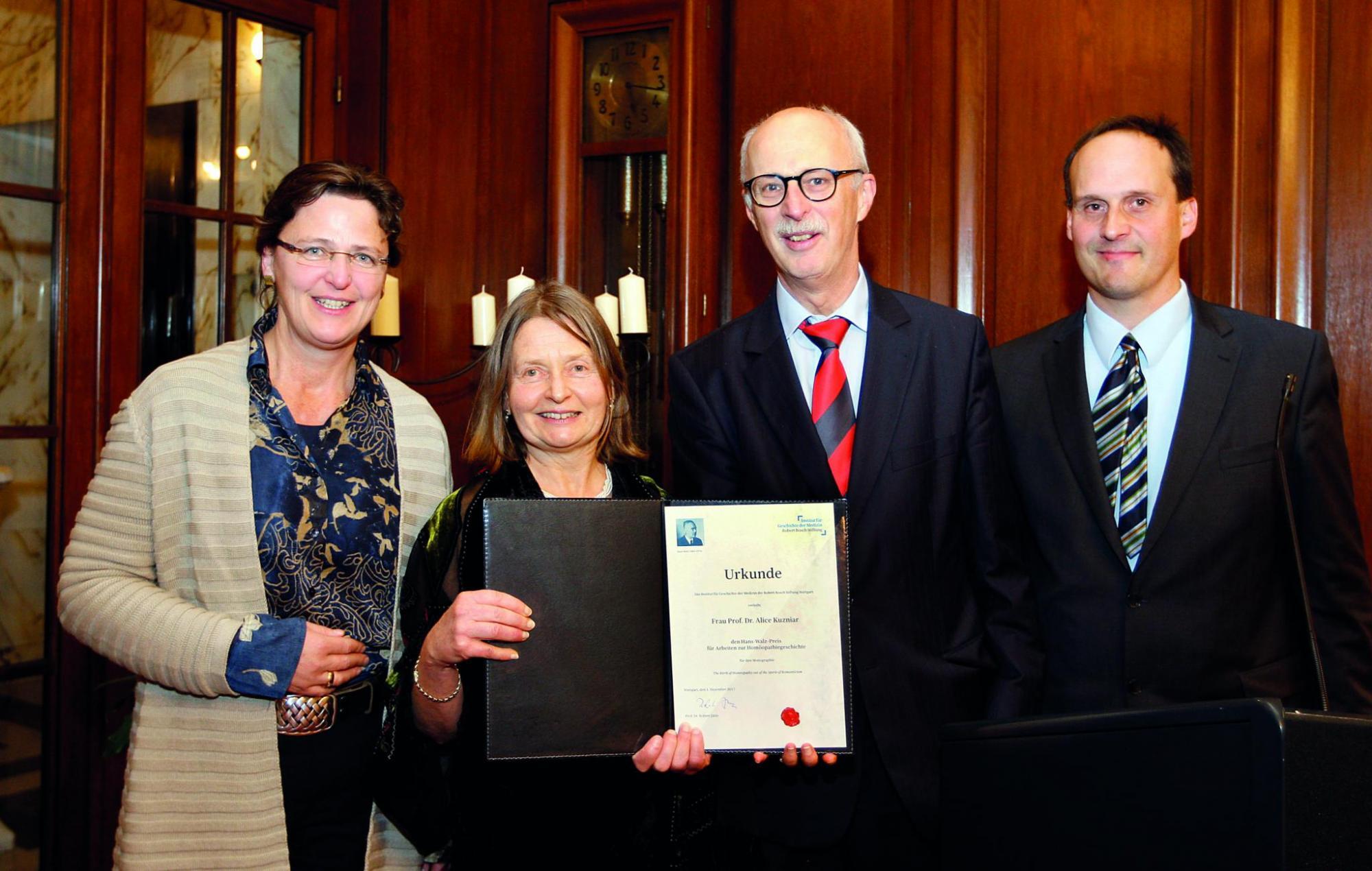
Alice Kuzniar receiving her Arts Award, April 19, 2017
More...
Researchers: stay up-to-date with Gateway
From the Office of Research: A website to keep faculty members and research administrators up-to-date on new online systems that support research is now live. The implementation of these systems will reduce the administrative burden, accelerate application processes, and create opportunities for collaboration. Visit the Research Gateway Program website to find out more about Pure, Kuali, and Policy 73.
Canada 150 Lecture Series
This fall, Arts, the City of Waterloo, and Wilfrid Laurier University's Faculty of Arts jointly present three public panel discussions in the local community. Watch University of Waterloo Events for details.
- October 4, Vimy Ridge, at Waterloo Public Library
- November 1, Truth and Reconciliation, at Knox Waterloo Presbyterian Church
- December 13, Hidden Histories, at Canadian Clay and Glass Gallery



Feedback?
Inside Arts is published each term. Comments, ideas, and submissions are always welcome. Please contact Wendy Philpott.
